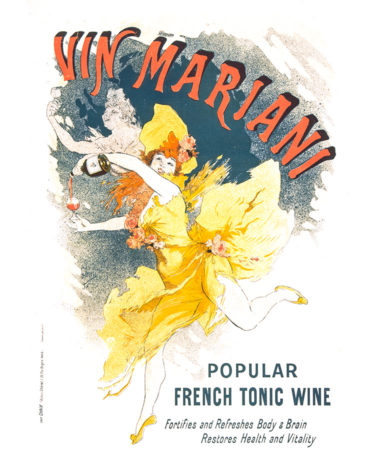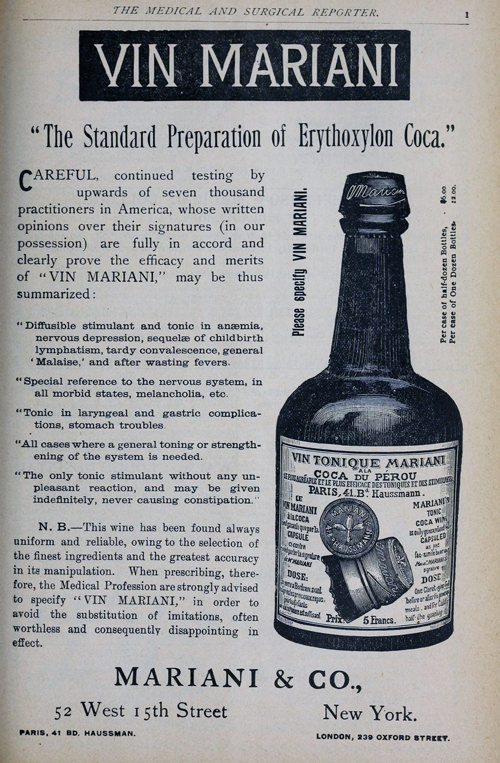Vin Tonique Mariani à la Coca de Peroum, known simply as Vin Mariani, was a ‘tonic wine’ that debuted in 1863 and shortly thereafter became a worldwide sensation. Invented by French chemist Angelo Mariani, who hailed from Corsica, the tonic came about due to his fascination with Paolo Mantegazza’s recent studies of the coca plant and its perceived benefits. The study inspired Mariani to combine ground up coca leaves with red Bordeaux wine, at the rate of 6 milligrams of coca per ounce of wine, and thus Vin Mariani was born. A proper ‘dose’ was two to three glassfuls per day, taken before or after meals (halved for children!). The product was marketed as a digestif, an aperitif, and a general cure-all. The delicious concoction promised to heal whatever ailed you and provide the energy boost needed by actresses, inventors and workingmen alike.
Vin Mariani was a massive hit. Mariani’s wine and coca tonic took his home city of Paris by storm, and then, the rest of Europe and the U.S. Seizing on the opportunity, Mariani opened offices in London, New York and Montreal. To support demand for his product in the U.S. he opened a second laboratory in New York. Vin Mariani had many competitors and imitators, but a shrewd, celebrity-driven marketing campaign earned him millions of dollars worth of sales. While Mariani’s ads claimed that thousands of doctors endorsed the product, it was the celebrity endorsers who really pushed the elixir. The ads he ran in newspapers and magazines featured countless politicians, actors, writers and religious leaders, all extolling the many virtues of Vin Mariani. Devotees of the drink included Alexander Dumas, Emile Zola, Presidents William McKinley and Ulysses S. Grant, and countless monarchs including Queen Victoria of England. In addition, actress Sarah Bernhardt and Pope Leo XIII (who gave him a Gold Medal!) were among the many who actually appeared in advertisements.
Medical Claims & Celebrity Boasts
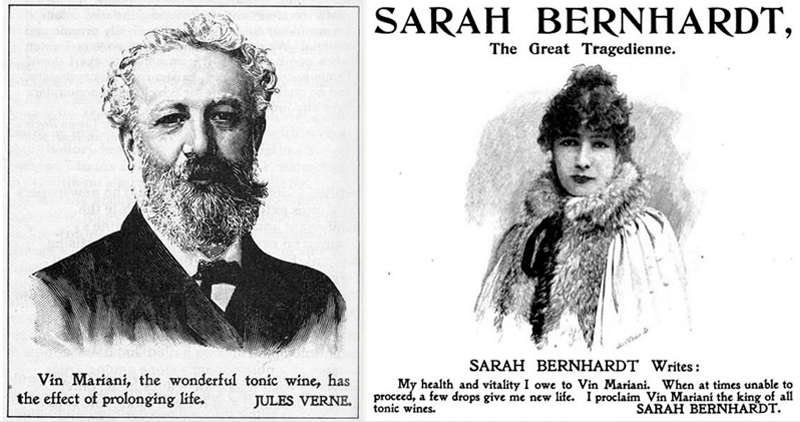
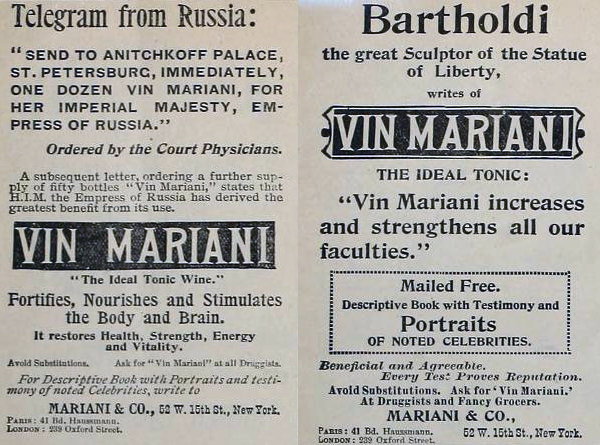
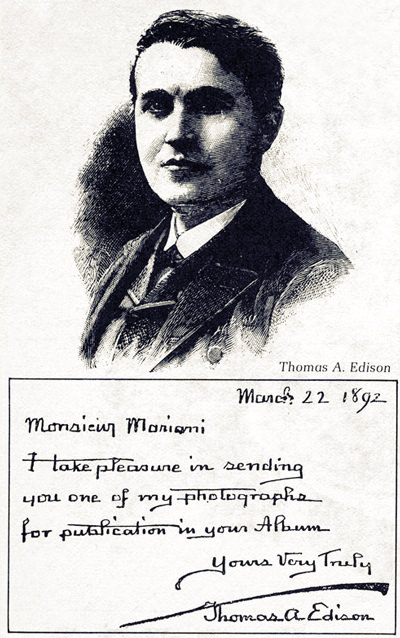
Mariani Claimed That Pope Leo XIII Awarded His Coca Wine A Gold Medal
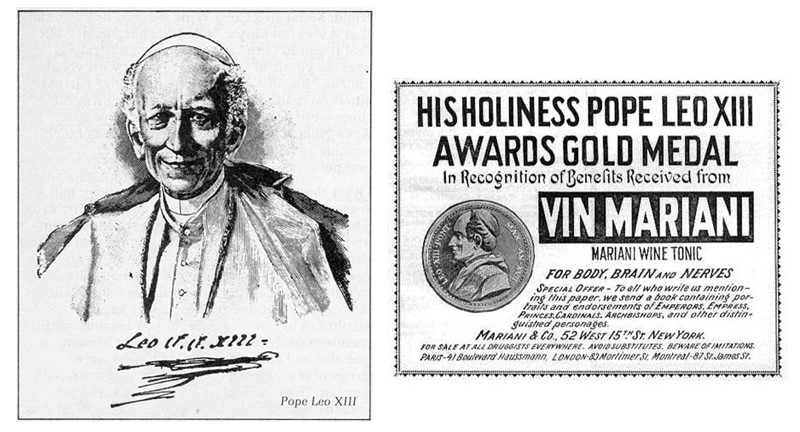
What did he receive that medal for? Another ad revealed that the Pope was a true believer in the product: “His Holiness THE POPE writes that he has fully appreciated the beneficient effects of this Tonic Wine and has forwarded to Mr. Mariani as a token of his gratitude a gold medal bearing his august effigy.”
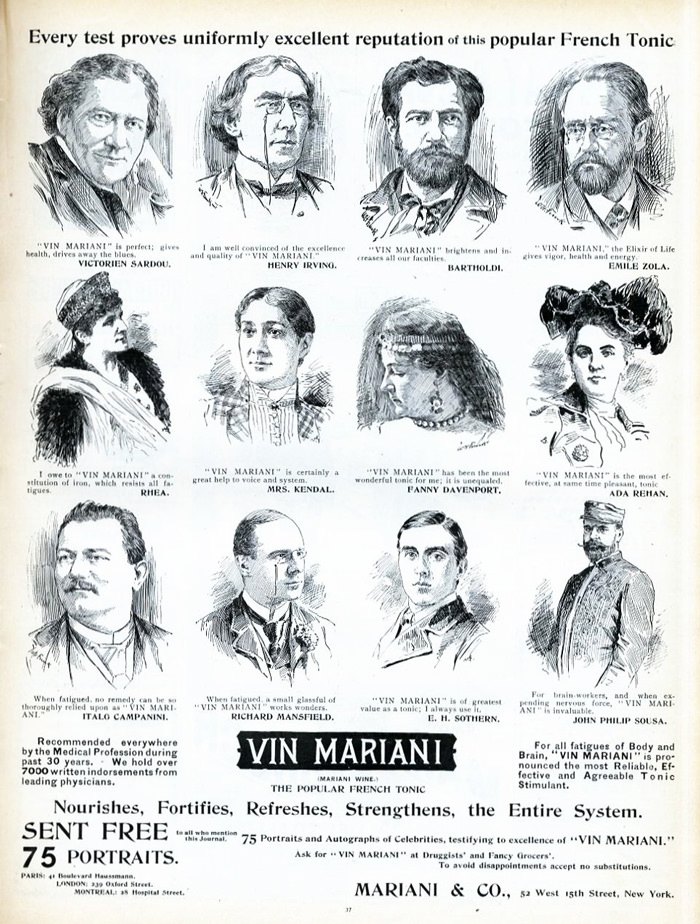
Competition Heats Up…
So many competitors sprung up, many offering inferior products, that Mariani’s company ran this ad in The Medical And Surgical Reporter around the turn of the century:
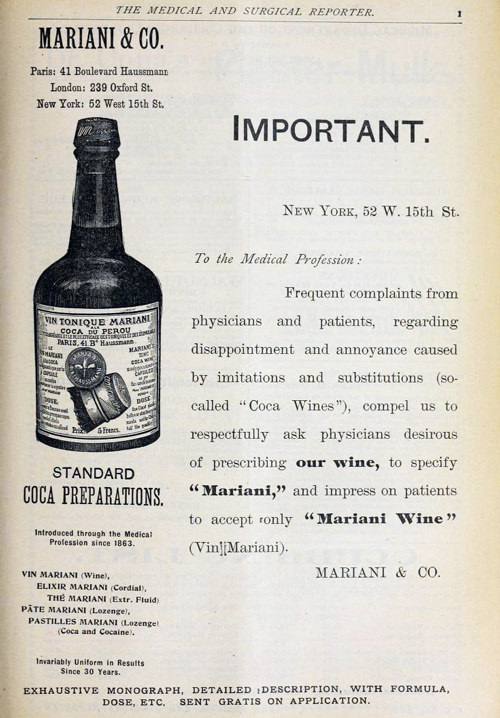
Angelo Mariani died in 1914, a few months before World War I would break out. By then his product was besieged by multiple foes, some in the U.S., others globally:
- The Pure Food and Drug Act of 1906, a law regulating the labeling of cocaine and heroin based products, should have forced Mariani to tone down his over-the-top health claims, along with the nature of the coca leaf in the final product. He seems to have fought on, sometimes decrying the law and those who opposed his products, other times claiming there was actually no cocaine in his product.
- Doctors of the day published reports in medical journals that suggested that Mariani was effectively fortifying his product, in his New York lab, from the 10% alcohol by volume he claimed to over 16% by dissolving the ground up coca in pure alcohol. This fueled fights with the U.S. government over whether his labels were accurate in stating his wine was indeed French, if it was being “prepared” (mixed with coca) in a New York lab. If his labels weren’t accurate, the argument went, his product shouldn’t be sold at all. The fight, apparently, went on, as the information seems to have been tossed aside as quickly as it was found. Only a few years ago, in 2011, researchers at the University of Guelph in Canada used MRI imaging on a preserved bottle from 1895 to apparently confirm that Mariani was, in fact, fortifying his wines.
- Alcohol prohibition movements in many countries limited the market for his product.
- Growing awareness around the world that cocaine, once hailed as a miracle drug by the medical community, was actually a dangerous drug, far from a cure-all, culminated in the United States in the Harrison Narcotics Tax Act of 1914, which further reined in the marketing of cocaine and opiate based products.
By some estimates, Mariani weathered the regulatory storm in the U.S. until as late as 1910. In some of his later ads the same celebrities appear, only the endorsements are written plainly (though the boasts were still there):
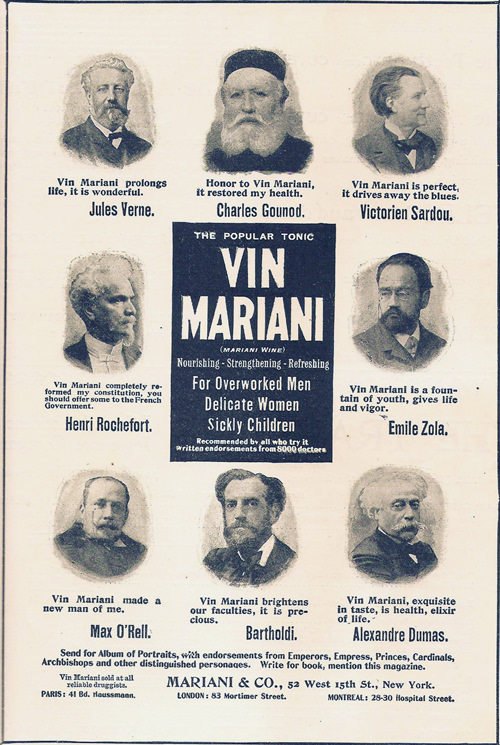
While Angelo Mariani earned a fortune, referred to a few years ago in The New York Times as “[probably] the world’s first cocaine millionaire,” one of his competitors went on to produce one of the world’s most famous beverages. That’s where the rise and fall of Vin Mariani takes an ironic turn.
There’s a story, likely a myth, that wine snobs love to pass around. It goes like this: About ten years ago, wealthy Chinese businessmen began buying up Bordeaux’s most expensive classified growths, causing demand and prices to soar. Those businessmen were purchasing the wine to flash their wealth or to present as gifts to seal business deals. They didn’t actually like the taste of the wine they were buying, so when they drank it, they mixed it with Coca-Cola. Quelle horreur! Do people mix red wine with Coca Cola? Of course they do. It’s called Kalimotxo. Would any sane person mix Château Lafite Rothschild or Château Margaux with Coca-Cola? Of course not. Has someone ever flashed their wealth doing so? Of course. Have you seen what people do with their champagne in nightclub VIP rooms?
What does this have to do with Vin Mariani? As we mentioned, the product was a tonic, one of many countless others being sold around the Western World at the time. One of Mariani’s American imitators was John S. Pemberton, a pharmacist living in Atlanta. Pemberton’s French Wine Coca, which debuted in 1885, was a moderate success. The drink was alcoholic, though the exact domestic source of its wine is unclear. That very same year, Atlanta and Fulton county passed legislation enacting local alcohol prohibition, which would take effect the following year. Pemberton scrambled to remove the alcohol from his drink. He christened his new non-alcoholic product Coca-Cola. Over 125 years later, if myths are to be believed, Pemberton’s coca drink (sans coca) was finally mixed with the finest Bordeaux has to offer.
